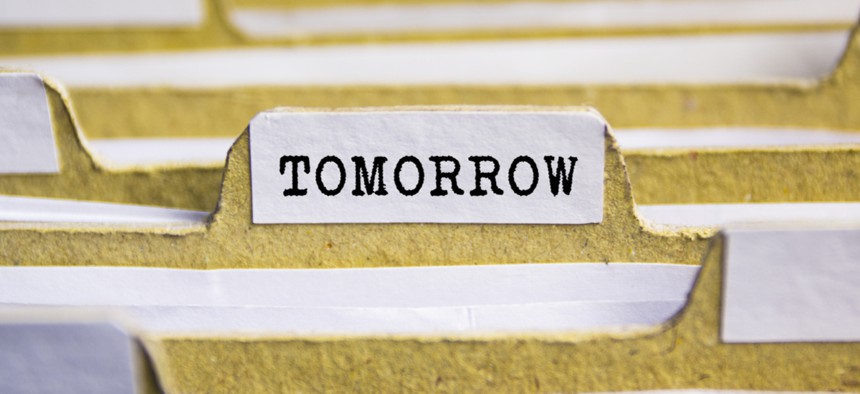Stop Procrastinating With a Research-Backed Mental Visualization Exercise

Sinart Creative/Shutterstock.com
This technique isn’t just for chronic procrastinators.
When we procrastinate, we are, in a sense, favoring one person at the expense of another: We’re offloading the obligations of our present self onto a future self who feels disconnected from the flesh and blood we are now. The more disconnected that other self feels, researchers have found, the easier it is to let present self off the hook.
On the other hand, you’re more likely to naturally avoid delays if you have a strong sense of what philosophers call “future self-continuity”, meaning you feel on a visceral level that the person you’ll be on deadline day is the same you who feels so real right now.
A team of psychologists at Northwestern and Stanford universities demonstrated how this works in a 2011 experiment involving retirement decisions. Researchers exposed the study participants to either digital avatars of their present self or to digitally aged versions. After seeing their virtual proxies with deeply etched laugh lines and cheekbones wrecked by gravity, members of the “future self” condition group were more likely to say they would allocate more money toward their retirement savings.
(Inspired by this line of research, Merrill Edge, an online brokerage service, created a digital tool called “Face Retirement” that briefly lived on its website in 2012. )
More recently, Eve-Marie Blouin-Hudon, a psychologist and researcher at Ottawa’s Carleton University, theorized that the same effects of the 2011 study could be replicated without the use of technology or selfies, but instead with a uniquely human talent: “the imaginative capacity of remembering the past and anticipating how our lives will unfold,” as she writes in her paper, published last year in the journal Applied Psychology. She wondered whether a person could achieve the same effects as those seen in the 2011 experiment using only a visualization exercise in which they saw their future self in their mind’s eye and spent some time with that self for about 10 minutes every day.
Blouin-Hudon tested her hypothesis by comparing the influence of that exercise with the effects of generic mindfulness-based meditation. She wrote custom scripts for each scenario and hired a professional voice actor to record them. The students who participated in the experiment were assigned to listen to one of the recordings twice per week for four weeks.
It worked. At the end of month, the students who had visualized their future selves reported feeling more overlap between who they were in the moment and who they’d soon become, and said they procrastinated less on their semester-end work compared to how much they’d typically procrastinate.
Blouin-Hudon believes that with a customized script, the same basic premise could work for anyone trying to conquer procrastination. Here’s how:
- Be specific about what you’re trying to fix. Picture yourself doing something that you tend to push off regularly, hoping that fate will magically remove it from your to-do list. Says Blouin-Hudon. “It could be eating healthy or going to bed early. It should be something for which, if you don’t complete it, you’ll really suffer.”
- Adjust your timeframe appropriately. This study had an obvious timeline: the school semester. The rest of us are dealing with different deadlines and rhythms, or what scholars of chronemics, the study of time and communication, call “pacers.”
- Use a third person perspective, as if watching yourself acting in a film. “It’s better to see your future self from a bird’s eye view,” says Blouin-Hudon. In her research, when her subjects were seeing their future from a first-person perspective, some seemed to become too emotionally connected, and more distressed, which made them more likely to procrastinate. “Be sympathetic to your future self,” says Blouin-Hudon, “not empathetic.”
- Imagine as much detail, and evoke as many senses, as possible. You might ask: What’s your future self wearing? (Imagine your real clothes.) What is the light like in the room? Can you smell the freshly ground coffee from the office pantry ? Even more specifically: What’s the feedback on the sales report that you handed in early or late? In your email messages, is there a message in which you’ve asked your boss for an extension? How does that feel?
- Settle on one or a few concrete steps you can take toward your goal. For some people, the visualization may be enough to kick-start action, but most people will need to commit to a few concrete steps to capitalize on their new sense of connectedness to their self of tomorrow. If the goal is to exercise, lay out your gym clothes. Or maybe you sketch a barebones outline of the memo that’s due at work.
Blouin-Hudon suggests practicing your future-self meditation daily or nearly daily, for as long as you feel is helpful, but a minimum of a month. Keep at it, even if you slip up a few times. If visualization doesn’t feel effective, try writing in a journal.
This technique isn’t just for chronic procrastinators, Blouin-Hudon says. Everyone can benefit from just being aware that we have this concept of a future self, and that we’re treating it like a totally different person. “Often times, we forget,” she says.
Listen to the nine-minute recording used in her experiment, below:
https://soundcloud.com/lila-maclellan-861121166


